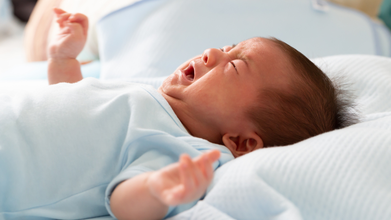- Health Conditions A-Z
- Health & Wellness
- Nutrition
- Fitness
- Health News
- Ayurveda
- Videos
- Medicine A-Z
- Parenting
How To Prevent Contagious Illness In Kids?

Credits: Canva
Kids love going around places, playing, and exploring new things. While all of this is fun, it can expose them to diseases. When they come from school, they are exposed to various germs through air and transmission or direct contact. They also touch surfaces a lot, then their face, then their mouths. This makes it easy for illness to spread. While it is impossible to prevent illness completely, there could be several measures that can reduce the risk and support recovery.
Vaccination
Vaccination is a critical step in preventing severe illnesses. The Centers for Disease Control and Prevention (CDC) and the American Academy of Pediatrics (AAP) recommend following an established vaccine schedule. Vaccines protect against life-threatening infections, including those that disproportionately affect infants and young children.
Good Hygiene
While no vaccine can prevent one from common cold, good hygiene practices can significantly reduce germ transmission. Parents must therefore encourage their children to wash their hands after touching toys, hard surfaces, and other people. What is more important is proper hand hygiene, as handwashing with soap and water is the most effective way to eliminate germs.
ALSO READ: This Spring, Make Hand Hygiene A Priority, Says Expert
The Hygiene Hypothesis: Does Exposure to Germs Strengthen Immunity?
There are several research that suggests that early exposure to germs may help develop a child’s immune system, a concept known as the "hygiene hypothesis." However, many immunologists argue against this theory, noting that children naturally encounter enough germs to build immunity without unnecessary exposure to unsanitary conditions. A balanced approach ensures children develop a strong immune response without increased risk of illness.
Cleaning and Sanitizing Children’s Belongings
Regular cleaning of toys, school supplies, and frequently touched objects is essential. Understanding the difference between cleaning, sanitizing, and disinfecting can help:
- Cleaning removes visible dirt and debris.
- Sanitizing reduces germs to safer levels.
- Disinfecting kills germs completely, offering the highest level of protection.
It is important to read product labels carefully, use child-safe cleaning products, and rinse toys thoroughly after disinfection, especially those that go into a child’s mouth.
Choosing Effective Sanitizing Products
To minimize germ exposure, parents should clean objects with soap and water first and then use a sanitizer for everyday items. Disinfectants, which are stronger, should be used on objects that a sick person has touched. The Environmental Protection Agency (EPA) provides a list of approved sanitizers and disinfectants that effectively kill germs.
Encouraging Good Hygiene Without Causing Anxiety
Teaching children proper hygiene without creating fear is essential. Make handwashing engaging by incorporating songs or counting games. Explaining the benefits of hygiene in a positive way helps children understand that washing hands protects them and others. Parents can reinforce these habits by leading by example.
Boosting Immunity Through Nutrition
A strong immune system helps children fight infections more effectively. Proper nutrition plays a crucial role in immune support. A balanced diet should include:
- Proteins
- Vegetables
- Fruits
- Healthy fats
- Carbohydrates
- Adequate hydration
Multivitamins are generally unnecessary for well-nourished children, but if supplements are used, they should be free of added sugars and taken under supervision to prevent choking hazards.
Teaching Respiratory Etiquette
Proper respiratory hygiene reduces the spread of illness. Parents should model behaviors such as covering their mouths with an elbow when coughing or sneezing. Using tissues and disposing of them immediately is also a good practice. Reinforcing these habits through positive encouragement makes children more likely to adopt them.
What Is Denmark's 'Cry It Out' Method Of Putting Babies to Sleep?

Credits: iStock
Sleep training is a key to a good night's rest. This is especially true for the parents who are still new with handling their babies. One such method of sleep training, famous in Denmark is called the 'cry it out' method.
However, this method has been long in debates, Especially with one side saying that allowing babies to bawl does no harm, whereas, other sets of research and studies suggest that it impacts babies' emotional quotient. In fact, research suggest that leaving the babies to cry could have knock-on effects including damaging the bond between parent and child and raising the infant's stress levels.
However, recently, 723 Danish psychologists signed an open letter stating that cry it out sleep method, known as the "good night and sleep well" method in Denmark should be discouraged, as such methods may risk the attachment and child's development.
What Exactly Is The 'Cry It Out' Method?
This is also known as the extinction method, where rather than answering your little one's crying call as soon as it goes out, you give them the opportunity to independently work it out and nod off. This method is not intended to be cruel, it is meant to be used as an intentional tool to teach your baby self-soothing techniques that will stick with them for life.
Some also call it same as going cold turkey on your child. Parenting experts say that you put your baby in their crib, say goodnight and shut the door.
The Debate Of Those In Favor Of Cry It Out And Those Against It
A study led by researchers from the University of Warwick and published in the Journal of Child Psychology and Psychiatry, followed 178 babies and their mothers in the UK from birth to 18 months. Mothers regularly filled out questionnaires explaining how often they let their baby “cry it out” shortly after birth, and again at three, six, and 18 months.
Researchers also observed mother-infant interactions through video recordings at three and 18 months. At 18 months, they assessed children’s behavior and attachment using parent questionnaires, psychologist reports, and observations of play.
The results showed that most mothers rarely let newborns cry. However, by 18 months, around two-thirds allowed their child to cry sometimes or often. Importantly, babies who were occasionally allowed to cry as newborns tended to cry for shorter periods by 18 months.
No Clear Evidence of Harm
The team found no negative effects on the child’s emotional attachment, behaviour, or the mother’s sensitivity by 18 months. Based on these findings, researchers concluded that the practice does not appear to cause harm.
Professor Dieter Wolke, a co-author of the study, said parents may have worried unnecessarily about the issue. He suggested that debates around crying may have been exaggerated.
The Ones Against The Cry It Out Method
Not everyone agrees that the findings settle the debate. Professor Amy Brown from Swansea University, who was not involved in the research, warned that the results should be interpreted carefully. She noted that very few mothers in the study regularly used the “cry it out” approach, and the study did not examine how long babies were left to cry or how distressing parents found the experience.
She also emphasized that the research does not prove controlled crying is beneficial, nor does it address the emotional toll it can take on caregivers.
The Developing Infant Brain
Some researchers highlight concerns about stress in early life. A baby’s brain grows rapidly in the first year, and intense distress triggers the release of cortisol, a stress hormone. In high levels, cortisol may harm developing neural connections. While the effects may not be immediate, some experts question whether repeated distress could have long-term consequences.
Stress, Self-Regulation, and Trust
Infants rely on caregivers to learn how to regulate emotions. When caregivers respond quickly and consistently, babies learn calmness and trust. Comforting a distressed baby helps build the foundation for self-soothing later in life.
Critics argue that leaving babies to cry may teach them to shut down emotionally rather than truly self-regulate. Over time, this could affect how children respond to stress and relationships.
The Role of Caregiver Responsiveness
Decades of developmental research show that caregiver responsiveness plays a crucial role in positive outcomes such as emotional regulation, social skills, empathy, and even intelligence. When caregivers are sensitive to a baby’s signals, it supports healthy brain and emotional development.
Because responsiveness is so influential, experts stress that any parenting approach should prioritize attentiveness to a child’s needs. While occasional crying may not be harmful, consistent care and emotional availability remain central to healthy development.
Baby Born From Liver? Pregnant Woman In Peru Delivers A Child Through Ectopic Pregnancy

Credits: Canva
A 16-year-old mother in Peru delivered a baby who was in placenta that attached to her liver.
This is a rare milestone as the baby has been safely delivering from an abdominal ectopic pregnancy in which the placenta was attached to the mother’s liver.
The case involved 19 year old Valeria Vela, whose pregnancy continued to 40 weeks and resulted in the birth of a healthy baby girl. Health authorities in Peru say this is the first documented case of its kind in the country and only the fourth reported worldwide in which both mother and baby survived.
Understanding the Rarity of Ectopic Pregnancies
Ectopic pregnancies occur when a fertilized egg implants outside the uterus. In most situations, they develop in the fallopian tubes.
Around 96 percent of ectopic pregnancies happen there and only a very small number occur in the abdominal cavity. These pregnancies cannot safely continue because the organs where the egg may attach are not designed to support a growing fetus. In this case, the egg implanted directly on the liver, which meant the fetus relied on the liver’s arteries for blood supply. This created a situation that demanded extremely careful monitoring, as even small shifts in blood flow could have been dangerous.
The Challenges Doctors Faced
For doctors, the biggest challenge was the placenta. Removing a placenta that has attached itself to the liver can cause severe bleeding that can quickly turn fatal. Peru’s Health Minister Luis Quiroz Avilés explained that any attempt to detach it without preparation could have caused life threatening hemorrhage in the mother.
To manage this, the medical team used a technique that closes the arteries feeding the placenta by blocking their blood flow. This approach helped prevent massive bleeding during surgery and gave both mother and baby a chance at survival.
Another extraordinary aspect of this case was that the pregnancy reached 40 full weeks. Previous live abdominal ectopic pregnancies that resulted in birth reached only up to 36 weeks. Doctors followed Valeria closely through her pregnancy and relied on advanced imaging and interventional radiology techniques to keep the situation stable. According to local reports, the clinical management required constant coordination among specialists from obstetrics, radiology, surgery and intensive care.
A Baby Born Against All Odds
The baby, named Aylin, was born on November 30 and weighed 7.9 pounds. Officials revealed the case only after both mother and child were safely discharged from the hospital. Valeria is now in stable condition and recovering well, while Aylin is reported to be healthy.
Why This Does Not Change Standard Care
Although the case has been described as a medical milestone, specialists emphasize that such pregnancies are exceptionally rare. Most ectopic pregnancies cannot continue and trying to carry them comes with severe risks that include hemorrhage, organ damage and even death. For this reason, early diagnosis and timely intervention remain the safest and most widely recommended approach. This case highlights what is medically possible under very specific circumstances, but it does not change established guidelines for managing ectopic pregnancies.
Is There A Link Between Social Media Use And Increased ADHD-Like Symptoms In Kids?

Credits: Canva
Do you feel like your attention span has gone down? Thanks to multiple social media platforms and its shorter duration content, we find ourselves losing attention and cannot keep up with anything that goes a little bit over a minute. This has not just affected us, but children are now being diagnosed with attention deficit hyperactivity disorder (ADHD) more.
A latest peer-reviewed study by Karolinska Institutet, which monitored more than 8,300 US-based children from age of 10 to 14 noted that social media use has lead to increased inattention symptoms.
The researchers of the aforementioned institute in Sweden, along with the Oregon Health & Science University in the US found that children spent an average of 2.3 hours a day watching television or online videos, 1.4 hours on social media and 1.5 hours playing video games.
The study found no connection between ADHD-related behaviors, such as distractibility, and activities like playing video games or watching TV and YouTube. However, long-term social media use was linked to rising inattention symptoms in children. ADHD is a neurodevelopmental condition marked by impulsiveness, trouble focusing and frequently forgetting everyday tasks.
. According to the researchers, “We identified an association between social media use and increased inattention symptoms, interpreted here as a likely causal effect.” They noted that while the impact on each child may be small, widespread behavioral shifts could have a meaningful effect at the population level. The study also suggested that growing social media use may be contributing to the rise in ADHD diagnoses.
Why Social Media May Disrupt Focus
Torkel Klingberg, a professor of cognitive neuroscience at the Karolinska Institute, said the findings pointed specifically to social media as a factor affecting children’s ability to concentrate. He explained that platforms bombard users with constant notifications and messages, and even the anticipation of receiving one can interrupt mental focus. “This affects the ability to stay focused and could explain the association,” he said.
The research also showed that socioeconomic background and genetic risk for ADHD did not change the observed link, suggesting that the distraction-rich environment of social media itself may be responsible. Klingberg added that increasing social media use could partly explain the rise in ADHD diagnoses among children, which grew from 9.5 percent in 2003–07 to 11.3 percent in 2020–22, based on data from the U.S. National Survey of Children’s Health.
Early Social Media Exposure Raises Concerns
The authors stressed that the study does not imply all children who use social media will develop concentration problems. However, they pointed out that many children begin using these platforms well before age 13, the minimum age for apps such as Instagram and TikTok. The report called for stronger age verification measures and clearer guidance from tech companies.
How Much Time Children Spend Online
The study tracked a gradual rise in social media use, from around 30 minutes a day at age nine to about two and a half hours by age 13. The children were enrolled at ages nine and ten between 2016 and 2018. The full findings will appear in the journal Pediatrics Open Science.
Samson Nivins, a postdoctoral researcher at the Karolinska Institute and one of the study’s authors, said the team hopes the results will help parents and policymakers make more informed decisions about healthy digital habits that support children’s cognitive development.
© 2024 Bennett, Coleman & Company Limited

